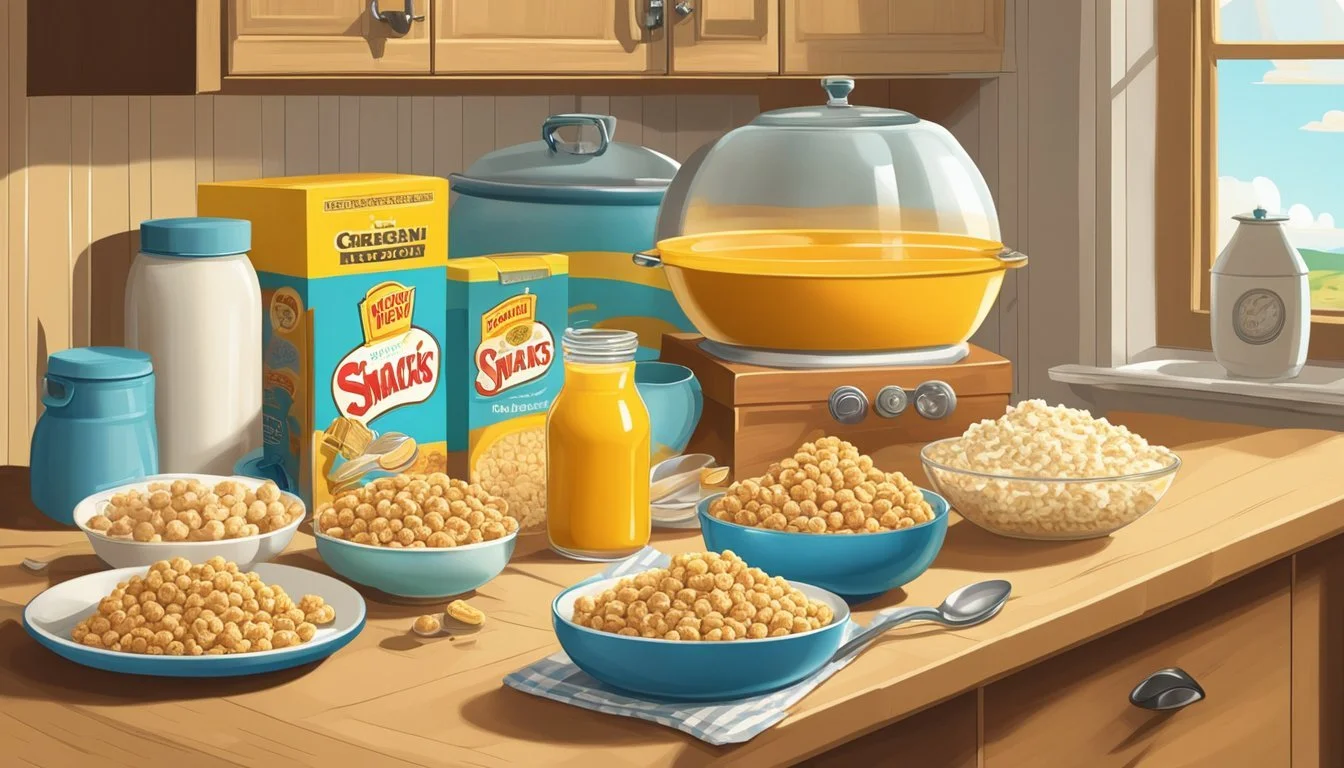Honey Smacks vs Rice Krispies
Comparing Nutritional Values and Taste
This Article is Part of Our Breakfast Cereal Guide with Details on Honey Smacks Nutrition and Rice Krispies Nutrition
When it comes to the breakfast table, there are few options as iconic as Honey Smacks and Rice Krispies. Both cereals have loyal followings and boast their own unique characteristics. For health-conscious consumers, Rice Krispies might take the lead with its lower added sugar content, providing only 4 grams per serving compared to Honey Smacks, which contain between 12 and 18 grams of added sugars per serving.
Honey Smacks, with their sweet, honey-flavored flair, are a tempting option for those with a penchant for sugary breakfasts. Meanwhile, Rice Krispies offer a simple, toasted rice flavor that is versatile enough to pair with a variety of toppings or simply enjoyed on its own. Each cereal has its merits, but the choice ultimately depends on individual taste preferences and dietary goals.
Exploring these cereals' nutritional profiles can help make the decision clearer. With the backdrop of Kellogg’s branding, both cereals ensure a level of quality and consistency. While Honey Smacks offer a sweet start to the day, Rice Krispies provide a lighter, less sugary alternative, making them a potentially healthier choice for many families.
Historical Background
Honey Smacks and Rice Krispies are two iconic cereals introduced by Kellogg. Each has a unique history that reflects changes in marketing, consumer preferences, and cereal production techniques.
The Origins of Honey Smacks
Honey Smacks, originally launched as Sugar Smacks, made their debut in the early 1950s. Created by Kellogg, the cereal was initially marketed as a sugary treat, capitalizing on the post-war era’s shift towards sweeter breakfast options.
The cereal consists of sweetened puffed wheat, known for containing a significant amount of sugar. Amid growing health consciousness, Kellogg rebranded Sugar Smacks to Honey Smacks in the 1980s, reflecting a move towards a seemingly healthier image. The name Smacks has varied in different regions, such as simply Smacks in some international markets.
The Emergence of Rice Krispies
Rice Krispies were introduced by Kellogg in 1928. This crispy rice cereal utilized a unique process where partially dried grain was shaped, dried, and toasted to achieve its distinctive crispness and iconic “snap, crackle, pop” sound when milk is added.
Kellogg's Rice Krispies quickly became a staple in American households. Over the decades, they have maintained their popularity, notably expanding into products like Kellogg's Rice Krispies Treats. The continuous innovation and consistency in quality have ensured that Rice Krispies remain beloved by many.
Nutritional Comparison
When comparing Honey Smacks and Rice Krispies, it is essential to look at various nutritional aspects to determine which is healthier. This analysis covers caloric content, sugar and carbohydrate levels, protein and fiber contributions, vitamins and minerals, and fat content.
Caloric Content and Serving Size
Honey Smacks:
Serving Size: 1 cup (approx. 27g)
Calories per Serving: 100 calories
Rice Krispies:
Serving Size: 1 cup (approx. 28g)
Calories per Serving: 110 calories
Both cereals are relatively low in calories per serving, but Rice Krispies has a slightly higher caloric content. This difference is minimal and should be considered in the context of the entire diet.
Sugar and Carbohydrates Content
Honey Smacks:
Total Carbohydrates: 23g per serving
Grams of Sugar: 15g
Rice Krispies:
Total Carbohydrates: 24g per serving
Grams of Sugar: 4g
Honey Smacks contains a significantly higher amount of sugar compared to Rice Krispies. This makes Rice Krispies a better option for those looking to reduce sugar intake. Both cereals have similar total carbohydrate content, but the source of these carbs differs, with Honey Smacks getting a bigger portion from sugar.
Protein and Fiber Contribution
Honey Smacks:
Protein: 2g per serving
Fiber: less than 1g per serving
Rice Krispies:
Protein: 2g per serving
Fiber: less than 1g per serving
Both cereals offer the same amount of protein per serving and have minimal fiber content. Neither option provides a significant source of fiber, which is important for a balanced diet. Those seeking higher fiber content would need to pair these cereals with foods richer in fiber, like fruits.
Vitamins and Minerals
Honey Smacks:
Vitamin B12: Present
Vitamin B6: Present
Vitamin B1: Present
Iron: Present
Selenium: Rich source
Rice Krispies:
Iron: 56% Daily Value coverage
Zinc: Present
Vitamin C: Present
Calcium: Present
Honey Smacks is rich in several B vitamins and selenium, making it a good source for these nutrients. Rice Krispies, on the other hand, stands out with a notably high coverage of daily iron needs and also provides zinc and vitamin C. Each cereal offers different vitamin and mineral benefits.
Fat Content Analysis
Honey Smacks:
Total Fat: 0.5g per serving
Saturated Fat: 0g
Rice Krispies:
Total Fat: 0g per serving
Saturated Fat: 0g
Both cereals are very low in total fat and contain no saturated fats, making them low-fat breakfast options. This is beneficial for those monitoring their fat intake for heart health or weight management.
This detailed comparison provides a clear view of how Honey Smacks and Rice Krispies measure up against each other in various nutritional aspects.




